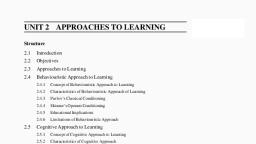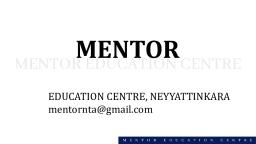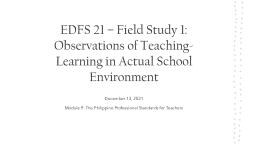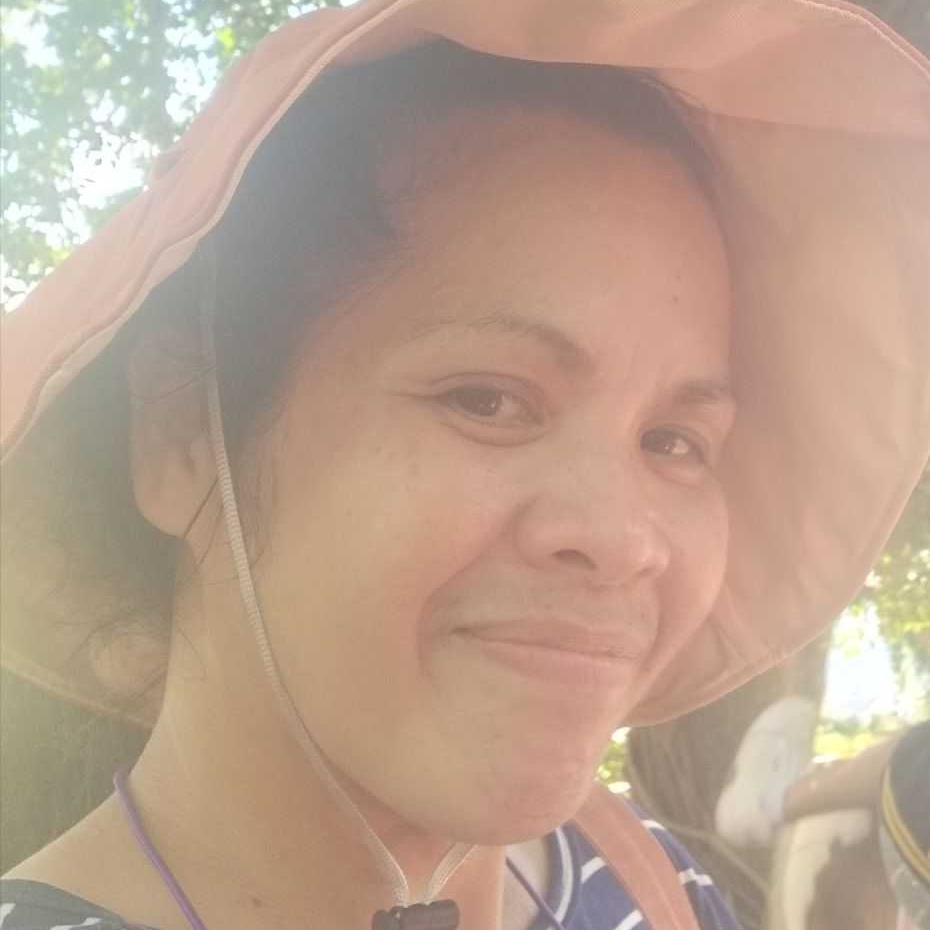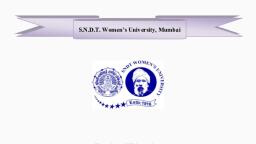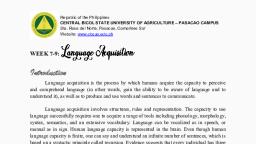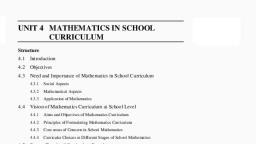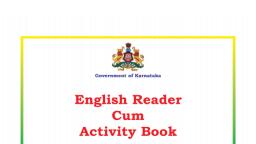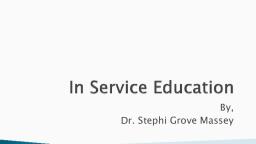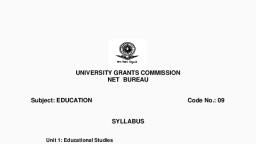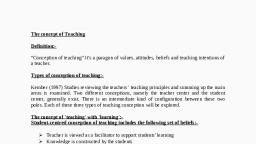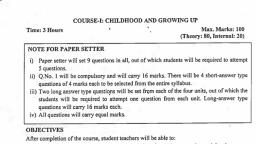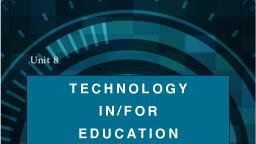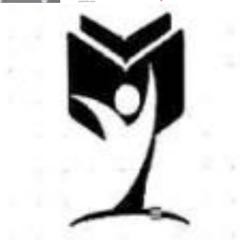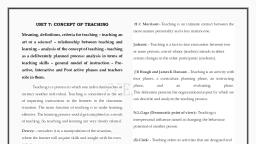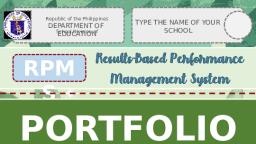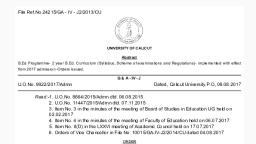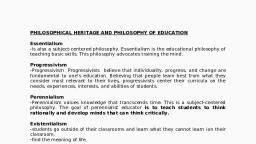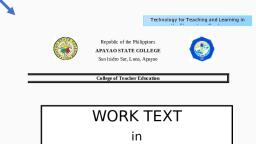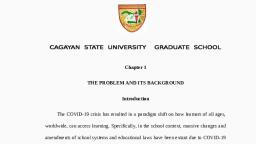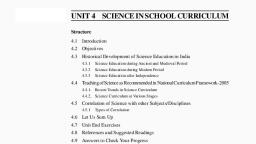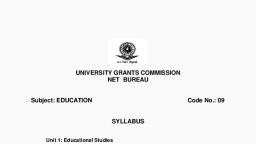Page 1 :
Learning: Perspectives and, Approaches, , UNIT 3 LEARNING FOR CONSTRUCTION, OF KNOWLEDGE, Structure, 3.1, 3.2, 3.3, 3.4, , Introduction, Objectives, Constructivism: An Introduction, Various Constructivists’ Ideas, 3.4.1, 3.4.2, 3.4.3, 3.4.4, 3.4.5, , 3.5, 3.6, , Dewey’s Contribution, Piaget’s Cognitive Constructivism, Vygotsky’s Social Constructivism, Bruner’s Constructivism, Novak’s Humanistic Constructivism, , Constructive Learning Environment, How Learning Takes Place?, 3.6.1, 3.6.2, 3.6.3, 3.6.4, , 3.7, 3.8, 3.9, 3.10, , Scaffolding, Cognitive Apprenticeship, Tutoring, Discovery Learning, , Let us Sum Up, Unit End Exercises, References and Suggested Reading, Answers to Check Your Progress, , 3.1 INTRODUCTION, In Unit two, we have discussed about various approaches to learning. After going, through the comparative perspective of various approaches, you must have, realized that constructivism has its distinguished relevance in learning. In last, one decade, Indian school education has transformed a lot and there is major, emphasis on constructivist teaching learning or we can say, promoting learning, for construction of knowledge by learners themselves. In present unit, we will, discuss various constructivist approaches and identify the essential elements for, creating a conducive learning environment. We will also discuss characteristics, of a constructivist classroom, which will help you to transform your class into a, constructivist class. The unit will end with reflections on how learning takes, place in a constructivist classroom., , 3.2 OBJECTIVES, After going through this unit, you will be able to:, , 50, , •, , understand various constructivist ideas towards learning;, , •, , identify the essential elements from various constructivist’s ideas,, , •, , create a constructive learning environment in your class, and, , •, , practice teaching-learning in constructivist discourse.
Page 2 :
3.3 CONSTRUCTIVISM: AN INTRODUCTION, , Learning for Construction, of Knowledge, , Learning for construction of knowledge is the basic presumption of constructivism, which is a paradigm contrary to traditional objectivist approach. National, Curriculum Framework-2005 emphesized that there is a ‘need to recognize the, child as a natural learner, and knowledge as the outcome of the child’s own activity.’, (p. 12). The emphasis is on such learning environment where children can construct, their own knowledge, develop their capacities and remain an active learner., In order to facilitate such learning, you as teacher need to be in tune with, constructivist approach of learning., Constructivism is not a single theory of learning. It is based on ideas proposed, by various philosophers, psychologists, anthropologists and educationists. You, must have heard of names like Piaget, Vygotsky, Novok or sometimes Dewey as, contributors to this new paradigm of learning., This approach is contrary to traditional objectivist approach which establishes, knowledge as something to be imparted into learners by some means like teacher., Objectivists assume knowledge as complete, real, objective and external to the, learner. This basic assumption was being questioned by a new approach which, believes that knowledge “is a function of how the individual creates meaning, from his or her own experiences”. Thus constructivism has emerged., Let us a start with an activity to identify the basic presumptions of objectivists, i.e. behaviorist and cognitivist:, Read the following statements and put a Ö mark in front of those, which, you feel are presumptions of behaviorists or congnitivist approach of, learning., Knowledge is already available and should be given to the, children., Knowledge is transmitted by more knowledgeable to less, knowledgeable person., Teacher should built stimulus-response associations by using, cues, examples, cases and rewards., Pre-assessment is important to decide, what should be taught to, learner., It is important to concentrate on what learners know and not on, what they do., Knowledge acquisition is a mental activity that takes place, through internal coding and structuring by the learner., Suitable learning strategies should be used to change the learner, to acquire desired knowledge., Knowledge can be analyzed, compartmentalized and present in, small chunks., Emphasis on structuring, organizing, and sequencing information, to facilitate optimal processing., This activity will help to understand basic presumptions of constructivism and, differentiate it from objectivist view point., , 51
Page 3 :
Learning: Perspectives and, Approaches, , Constructivism is not altogether different approach but it has its distinguished, characteristics to place it in a different domain., The basic characteristics of constructivism, to which most constructivists agree,, are:, •, , Knowledge is an active meaning making process, in which learners construct, their own meaning. It is not something which is imposed by the teacher on, the learner., , •, , Learners have their own ideas about a situation, which may be incomplete, but they play an important role in building meaning and understanding the, situation., , •, , Learner’s social and cultural background has its significant impact on learners’, ideas., , •, , Learners construct their knowledge through interaction, perception and, experience., , Can you define constructivism by keeping these basic presumptions in mind?, Activity 1, Define constructivism in your own words, keeping the basic assumptions, in your mind., ......................................................................................................................, ......................................................................................................................, ......................................................................................................................, ......................................................................................................................, From above discussion, you must have understood that constructivism emphasizes, on the active role of the learner in developing understanding and making their, own meaning based on their previous knowledge and experiences in a new, situation., Let us now try to understand various viewpoints of constructivist which will, help you to develop your perspective of constructivism as per your understanding., Check Your Progress, Notes: a) Write your answer in the space given below., b) Compare your answer with the one given at the end of the unit., 1) What are basic assumptions of constructivist learning?, ..............................................................................................................., ..............................................................................................................., ..............................................................................................................., ..............................................................................................................., ..............................................................................................................., ..............................................................................................................., 52
Page 4 :
3.4 VARIOUS CONSTRUCTIVISTS’ IDEAS, , Learning for Construction, of Knowledge, , In previous section, basic assumptions of constructivism have been discussed. It, was clarified that constructivism is not a single theory and various constructivists, have their own vision about it. Major contributors to constructivism are Piaget,, Vygotsky, Bruner, Novek, etc. though it has its roots in the views of Dewey., , 3.4.1, , Dewey’s Contribution, , Though at the time of Dewey, there was no term like constructivism but he is, often referred to as philosophical founder of this approach. If you analyze his, vision of learning, you will be able to draw few conclusions like:, •, , He proposed that learners should engage in real-world and not in a preplanned environment., , •, , Learners should demonstrate their knowledge through creativity and, collaboration., , •, , Learners should be provided with opportunities to think from themselves, and articulate their thoughts., , He emphasized that education should be based on real life experiences. He wrote,, “If you have doubts about how learning happens, engage in sustained inquiry:, study, ponder, consider alternative possibilities and arrive at your belief grounded, in evidence.”, , 3.4.2, , Piaget’s Cognitive Constructivism, , Piaget has a firm belief that learning is influenced by the developmental stages, of learner. He is of the view that learning is a constructive process. In his own, words:, Knowledge is not a copy of reality. To know an object, to know an event, is not, simply to look at it and make a mental copy or image of it. To know an object is, to act on it. To know is to modify, to transform the object, and to understand the, process of this transformation, and as a consequence to understand the way the, object is constructed. (Piaget, 1964, p. 8), Thus, Piaget emphasized on an active learner who can observe, act, modify,, manipulate, transform and construct own meaning of an object or event. But it is, possible when learner is in appropriate developmental stage. You must have got, an idea of all the four developmental stages of children as proposed by Piaget,, i.e. sensorimotor, preoperational, concrete operational and formal operational, in Unit 2., Piaget proposed that learning takes place through some basic tendencies. He, named these tendencies as Organization, Adaptation and Equilibrium. He, proposed that some mental structures ‘schema’ develops based on perception, and experience, these ‘schema’ are organized through the processes of, assimilation and accommodation and equilibrium emerges., Let us try to understand these terms in a classroom situation., 53
Page 5 :
Learning: Perspectives and, Approaches, , Ms. Neha is a science teacher in a secondary school of Uttarakhand. In, her class of classification and characteristics of leaves, following has, happened., The moment Ms. Neha entered in the class, children were playing and they, saw their teacher with various types of branches and twigs with leaves in, her hand. She handed over all branches and twigs to children and asked, them to do something interesting., Children distributed those amongst them by making six groups and tried, many things like placing them in form of a garden, few tried to collect, leaves from branches and arranged according to size, shapes, etc. One, group decides to identify the name on plants, which have those different, leaves., After 15 minutes, she asked children to tell, what they have done and why., Following were the responses:, Group 1 : Ma’am, we made a garden where plants of short height and, small leaves are on sides while plants with long leaves and, higher are in middle. We do so because all leaves need proper, light and if we place big plants/tress on side, it will difficult to, smaller plants to get proper light., Group 2 : Ma’am, we tried to identify plants and from where these leaves, have been taken, because different kind of plants has different, types of leaves., Group 3 : Ma’am, we made different groups of leaves based on their, size and shapes., Group 4 : We arranged leaves in the way these are attached to the branch., We found few leaves are directly linked to main branch while, few leaves are in a group of three or five or more on a single, strand and this strand is attached to the branch. We also noted, that few have a base while few directly emerge from branches., Group 5 : Ma’am, we tried to identify the leaves and linked it with the, knowledge givenby our grandparents and parents about the, uses of these leaves. We found few are used as vegetables; few, as medicine while few as decorative., Group 6 : We arranged the leaves based on the distribution of veins in, leaves. In few leaves it is like a matrix while in some it is like, parallel lines., She was very impressed with the variety of thoughts presented by children., Though she was aware that they don’t know the technicalities of, classification of leaves based on various parameters but they knew many, things which she wanted to explain., , 54, , She put few cards in front of class having some terms like: usage, shape,, venation, size, adaptation, etc. and asked groups to choose one card which, suits their work. She was amazed to note that most of groups have chosen, the appropriate card. It has helped her to introduce the concept of, classification of leaves.
Page 6 :
Let us try to analyze and find out how the terms proposed by Piaget are fit in this, context., , Learning for Construction, of Knowledge, , Schema: Colour, size, use, shape, place in garden are certain schemas, which, different children have in their mind based on their observation, perception and, experience., They tried to organize their knowledge and used their existing schema to fit in, the situation given to them; this is called assimilation, i.e. the process of, explaining and understanding new information with the help of already existing, schemas., When few of them found the leaves they were not aware of and they used their, knowledge to understand and fit in new leaves in an articulate group i.e. they, adopted, modified or adjust their already existing schema to understand new, things/information/situation, this is called accommodation., When Ms. Neha gave them some cards and they chose one, which was most, appropriate to their way of classifying the leaves, they were satisfied. Getting, satisfactory understanding of information by using process of assimilation, and/or accommodation is equilibrium., Piaget also proposed that if satisfaction does not occur by applying schema through, process of assimilation or accommodation, it results in disequilibrium, which, motivates the learner to search and find the solution which can give satisfaction., Activity 2, Identify a real classroom situation in your class. Analyze it in relation to, following terms:, Schema(s) ........................................................................................................, ......................................................................................................................., Assimilation .................................................................................................., ......................................................................................................................., Accommodation ..........................................................................................., ......................................................................................................................., Situation of equilibrium: .............................................................................., ......................................................................................................................., ......................................................................................................................., Situation of disequilibrium:, ......................................................................................................................., ......................................................................................................................., , 3.4.3, , Vygotsky’s Social Constructivism, , Vygotsky is known as the proposer of social constructivism. Social Constructivism, approach talks of importance of social interaction and context in learning. He, believes that learning is social in nature. Through interactions children shared, their views and make their own meaning. It does not focus much on individual, 55
Page 7 :
Learning: Perspectives and, Approaches, , learning rather it emphasized on social context; knowledge is mutually built and, constructed., Knowledge is distributed among people and environments, which could be, developed best by cooperation and interaction with others. Opportunity to children, to interact with elders at home or in community, other children in class or in, playground helps them to refine their own thoughts and they develop a shared, vision or understanding of a situation/event or object., Vygotsky is of the view that teacher should provide an environment to children, to construct knowledge with peers and teacher i.e. co-construction of knowledge., He emphasized on the role of culture on learning. Culture helps in acquiring, appropriate skills. Here culture is not only classroom culture rather culture as a, social culture where children live, grow and learn, which includes family,, neighborhood, community and society as a whole., Vygotsky’s idea of Zone of Proximal Development (ZPD) has explained the, role of interaction in learning. It is an area where a child cannot solve a problem, alone but can do successful if an opportunity to interact with a more experienced, peer is given., Here are few examples, similar examples you can also observe in classroom, situation:, Example 1: Rahul, a 10th class student was trying to solve some mathematics, problems related to trigonometry. He tried many times but failed., His teacher asked questions to him, which lead him to follow, right approach and he succeeded to solve the problem., Example 2: Jasmine in her chemistry practical class was trying to use pipette, during titration practical. She used a 5 ml pipette but her, readings were not correct. When she got frustrated, her friend, Ranjita came to her. Ranjita guided her to hold and drop, chemical properly, she got succeeded and got desired results., In above example, you can see how the child move from lower limit to upper, limit in ZPD and enjoy successful learning with the help of more experienced, person., To use the concept of zone of proximal development, you can follow a step by, step process, which will help learners to construct their knowledge:, , 56, , •, , You should identify the already known to the learners. After knowing about, it, you should plan the situation where a new concept can be developed by, linking it with learners’ prior knowledge., , •, , While planning the less, you should design such situation and activities,, where most of learners can reach success. You should also identify few points,, where the learners need your support or peer interaction., , •, , Design variety of situations based on various realistic contexts, because all, learners will not learn in same way as well as their prior knowledge is not, similar., , •, , Ask learners to compare what they learnt and what was already known before, the task. Encourage them to enjoy their new learning and express their, feelings.
Page 8 :
Tharpe & Gallimore (1988) also expressed that ZPD is a four-stage process:, , Learning for Construction, of Knowledge, , Stage 1 : Assistance provided by More Knowledgeable Others (MKO’s) or, capable peers, Stage2, , : Assistance provided by self, , Stage 3 : Automatization through practice, Stage 4 : De-automatization; recursiveness through the previous three stages, Vygotsky is of the view that it is possible through any social interaction i.e., interaction with teacher, interaction with peer, interaction with parents, friends, or people in community. He called these the ‘buds’ or ‘flowers’ of development,, to distinguish them from ‘fruits’ of development, which the child already can, accomplish independently. (Vygotsky, 1978). One more concept linked with ZPD, is of Scaffolding, i.e. a technique to provide right kind of support in right, amount at right time to increase child’s competence. It will be discussed in, details in section 3.5.1., In contrast to Piaget, Vygotsky emphasized on role of language in learning. In, Piaget’s constructivism, child’s language was ecocentric and nonsocial speech,, but for Vygotsky, children use a lot of private speech not only from social, communication but also to plan, guide and regulate their behavior in selfregulatory fashion. He has a firm belief that the children who use a lot of private, speech are more socially competent than those who don’t., Vygotsky argued that there is a need to assess child’s ZPD in place of IQ. Before, beginning instruction, more experienced person should assess a child’s ZPD, through giving tasks with varying difficulties to assess, from where teachinglearning should begin., Check Your Progress, Notes: a) Write your answer in the space given below., b) Compare your answer with the one given at the end of the unit., 1) Till now, you have gone through the views of Piaget and Vygotsky,, Identify few points in both views which are contrasting, and compare, them., ..............................................................................................................., ..............................................................................................................., ..............................................................................................................., ..............................................................................................................., ..............................................................................................................., , 3.4.4, , Bruner’s Constructivism, , Jerome Bruner is a 20th century constructivist. If you go through Bruner’s ideas, on constructivism in his book ‘The Process of Education’, published in 1960,, you will find him an extension of Vygotsky. His work is much influenced by, Vygotsky’s idea of social constructivism, which resulted in the famous theory of, scaffolding, i.e. providing support to learners in their initial phase of learning,, which is in right amount and gradually decreases as learner progresses., , 57
Page 9 :
Learning: Perspectives and, Approaches, , Basic assumptions in Bruner’s social Constructivism are:, •, , Children construct their own new ideas and concepts based on their existing, knowledge., , •, , Learning is an active process. Process of learning takes place thorough, selection and transformation of information, decision making, generating, hypotheses, and making meaning from information and experiences., , •, , Comprehension of a subject is always better if a learner has understood its, fundamental structure. For this, he emphasized on the significance of, categorization in learning. “To perceive is to categorize, to conceptualize is, to categorize, to learn is to form categories, to make decisions is to, categorize.” Interpreting information and experiences by similarities and, differences is a key concept., , •, , Interest in a subject is best stimulus for learning., , Bruner also proposed an idea called spiral curriculum or readiness for learning,, where children are given basic idea about various concepts initially according to, their cognitive abilities, around which they develop their understanding and, construct knowledge more deeply, as progress in school years. He also emphasized, on the role of social environment in the acquisition of language., Another significant contribution of Bruner is in form of three stages of intellectual, development. He proposed in “Enactive” phase a child learns through action on, physical objects and the outcomes of these actions. The Second phase he named, as “Iconic”, where learning takes place with the help of models and pictures. In, third stage i.e. “Symbolic”, child develops the capacity to think in abstract terms., On the basis of these three stages’ idea, he proposed that for effective learning, a, combination of concrete, pictorial then symbolic activities should be used., Bruner’s contribution as proposer of ‘discovery learning’ is also very significant., In discovery learning, learners actively construct the meaning of structures and, identify the principles on their own. We will discuss about it details in section, 3.6.4 of the unit., Check Your Progress, Notes: a) Write your answer in the space given below., b) Compare your answer with the one given at the end of the unit., 3) What are the similarities in the views of Bruner and Vygotsky?, ..............................................................................................................., ..............................................................................................................., ..............................................................................................................., ..............................................................................................................., 4) What are three stages of Intellectual development according to Bruner?, ..............................................................................................................., ..............................................................................................................., ..............................................................................................................., 58
Page 10 :
3.4.5, , Novak’s Humanistic Constructivism, , Learning for Construction, of Knowledge, , Joseph. D. Novak’s ideas of learning are highly influenced by Ausubel’s, assimilation theory. He proposed construction of knowledge through meaningful, learning. In his words, ‘Meaningful learning underlies the constructive, integration of thinking, feeling and acting leading to empowerment for, commitment and responsibility.’ He argued that the process of meaning making, begins when a child observe or record any object or event. Child tries to identify, a relationship between his previous experiences and what is observed, this, facilitates construction of new knowledge. According to him, “Significant new, insights may occur when concepts and propositions in one domain of knowledge, can be related in some important way to concepts and propositions in another, domain of knowledge.” His idea is that learner should be incharge of his/her, learning. He is also of the view that in acquisition of new knowledge, emotions, also play an important role. He called his views on constructivism as ‘Human, Constructivism’., His one more significant contribution to understand learning process is in form, of ‘concept maps’. We will discuss in detail about concept maps in unit 9 of, block two. He said that concept maps are the tools, which can help in meaningful, construction of new knowledge by examining the existing relationships and, deriving new relationships. Concept maps help a learner to organize the scattered, views at one place and establish relationships. These maps help learners to learn, how to think critically and more creatively. Concept map can also be used as, assessment tool, which can help in improving the quality of learning., He said that a teacher should create an environment and help learners in sharing, the materials. Learners should develop their own meaning from material. A teacher, should appreciate what a learner is learning and tell them that their understanding, is never complete. Learning should be an interactive process. He defined learning, as:, Learning is also an affective experience; it is the pain and anxiety of confusion,, and the joy and excitement when one recognizes that new meanings have been, acquired. In my view, the construction of new knowledge in any field is no more, than a special kind of meaningful learning., Activity 3, Go through the above discussion about Novak’s view of learning and identify, five key points which are establishing him as constructivist thinker., , 3.5 CONSTRUCTIVE LEARNING ENVIRONMENT, Till now we have discussed about constructivist’s view, which will help you in, understanding the basic epistemology of constructivism, but the real challenge, for you as teacher is to create a suitable teaching-learning environment. In present, section, we will discuss about constructive learning environment and what can, we do to develop such environment?, What is constructive learning environment?, A learning environment facilitating learning through construction of meaning, and development of understanding among children on their own may be viewed, as a constructive learning environment., , 59
Page 11 :
Learning: Perspectives and, Approaches, , Maor (August 1999), identified five key practices of constructive learning, environments, which are:, •, , Personal constructions of reality i.e. whatever children construct within, their own mind, is their own reality. They construct their own meaning based, on their experiences. Knowledge comes from their experience. It does not, come from someone else., , •, , Simulated authentic learning environments i.e. the learning environment, designed and developed on the basis of real life experiences. A teacher has, to simulate the real life situations, problems and complexities for learners to, give them an opportunity to find their solutions. Authentic learning does not, mean providing ample of information; rather they should porvide, opportunities to develop their deep understanding. Children construct their, knowledge in such an environment and relate their prior knowledge with the, context. Contextualization of learning is also an important characteristic of, authentic learning., , •, , Multiple Perspectives i.e. providing opportunity to experience various, dimensions. As you are aware, constructivism does not support sequential, and linear approach of learning, as a teacher, you should provide your learners, opportunity, where they can gather information with various perspectives., There should be opportunity to see the same concept in various ways and, develop understanding with varying objectives and expectations. You should, also keep in mind that all children don’t learn in same way. They have different, ideas, different experiences, different learning styles and different way to, look on a problem/situation. Learners should create knowledge, not reproduce, it. It should be your concern., , •, , Active learning is a situation where children construct their knowledge by, their active engagement in learning process. It is in contrast to objectivist,, where knowledge was supplied by teacher or more learned person to a young, learner or less knowledgeable person. Learning does not mean only passive, receiving or acquiring of information or only listening. You should understand, that knowledge transmission is not knowledge creation. You should provide, a learning environment where learners actively create their meaning and, develop their understanding through their active engagement in various, contexts. A learning environment promoting participation, cooperation,, collaboration for construction of knowledge is basically an active learning, environment. There are strategies like simulations, role-playing, multimedia, supported learning environments, games, intentional learning environments,, storytelling, case studies, dialogues, scaffolding, learning by design, group, cooperation, collaborative learning, etc., which promotes active learning., , •, , Collaboration is another key practice of a constructive learning environment., As a constructivist teacher you should be clear that collaboration is not a, means to acquire knowledge from someone else, rather it is a means to create, individual meaning with the help of others. It is a key learning tool in, Vygotsky’s social constructivism., , Jonassen (1995) have stated that:, Groups don’t learn, individuals learn. While learners may be part of a group, while learning, while learners may learn from one another, and while the social, 60
Page 12 :
context of a learning environment may provide support for its members; the, change in cognitive structure, the acquisition of knowledge and skill is an, individual event., , Learning for Construction, of Knowledge, , Hence, collaboration should be used as a learning strategy in a constructivist, classroom., Who will create it?, Answer to this question is you, i.e. teacher. A teacher will create such environment, to facilitate construction of knowledge in classroom. You have to create such a, learning environment where learners can collaborate, create, discuss and develop, their own understanding, where they are free to experiment with existing ideas, and get opportunity to explore on their own. Your role will be of a facilitator, only., Brooks and Brooks (1993) identified few characteristics of a constructivist teacher., According to him, a constructivist teacher is someone who will:, •, , encourage and accept learner’s autonomy and initiative;, , •, , use a wide variety of materials, including raw data, primary sources, and, interactive materials and encourage learners to use them;, , •, , inquire about learner’s understandings of concepts before sharing his/her, own understanding of those concepts;, , •, , encourage them to engage in dialogue with the teacher and with one another;, , •, , encourage learner inquiry by asking thoughtful, open-ended questions and, encourage learners to ask questions to each other and seek elaboration of, learners’ initial responses;, , •, , engage learners in experiences that show contradictions to initial, understandings and then encourage discussion;, , •, , provide time for learners to construct relationships and create metaphors;, , •, , assess learner’s understanding through application and performance of openstructured tasks., , These points indicate you have an important role in developing constructive, learning environment., Can you reflect for a moment?, Activity 4, Observe a class of your colleague for continuously one week and discuss, your observations with your colleague. Suggest the ways to create a, constructive learning environment in his/her class., (You can do same practice for you also. Ask any colleague to observe your, class and give you suggestions.)., , 61
Page 13 :
Learning: Perspectives and, Approaches, , Check Your Progress, Notes: a) Write your answer in the space given below., b) Compare your answer with the one given at the end of the unit., 5) What are key practices in constructivist classroom environment? Give, one example for each from your classroom experiences. ., ..............................................................................................................., ..............................................................................................................., ..............................................................................................................., ..............................................................................................................., ..............................................................................................................., , 3.6 HOW LEARNING TAKES PLACE, Till now, we have discussed about various constructivist ideas and how a, constructive learning environment can be created. During discussion, you must, have identified few concepts, proposed or discussed by various thinkers, which, have their role in the process of learning. There are discussions about scaffolding,, cognitive apprenticeship, tutoring, active learning, meaningful learning, concept, mapping. Few of them will be discussed in coming units of the course, but few, are important to be discussed here as these have their direct linkage with the way, learning takes place in a constructive learning environment., , 3.6.1, , Scaffolding, , We have already discussed a little about scaffolding while discussing about ZPD, in section 3.4.3 as well as in 3.4.4 while discussing ideas of Bruner. Idea of, scaffolding is a key concept in social constructivism., Scaffolding can be defined in simpler terms as “a technique to provide right, kind of support in right amount at right time to increase child’s competence.”, It helps a learner to move from a Zone of Actual Development to Zone of Proximal, Development and finally reach to Zone of Desired Development, with the help, of a more experienced person like, peers, elders in family, or teachers., When a teacher starts supporting learner initially for learning, and gradually, reduce the support till the learner reachesa situation, where s/he can develop his/, her own meaning and understanding independently. Teacher is scaffolding the, learner., Let us read the following case, and try to develop a clear understanding about, scaffolding., Read and analyze the following case and try to answer the questions., , 62, , John, a Geography teacher in a rural school of Kerala, was in a class of, mapping. Learners were expected to read maps as well as draw a, geographical map and indicate important places, rivers, etc., in the map. It, is a class with learners from diverse backgrounds, so he tried following, strategies:
Page 14 :
1), , For one group of learners coming from same village, he asked to draw, the path from their home to school on a sheet and mark important, places, or something can be used to describe right path., , 2), , For second group, he gave the map of Kerala state and asked to identify,, which they felt was interesting in the map and should be the part of, their map., , 3), , In third group, he asked to discuss about various important places,, rivers, etc. known to them and use their knowledge to develop a map., , Learning for Construction, of Knowledge, , Can you reflect on following questions?, •, , Why John gave three different tasks in same class?, , •, , Why to one group John gave map of Kerala but not to the other group?, , •, , Do you think all groups need similar support from John?, , •, , Which group needs more scaffolding then others?, , From above case, you can draw a conclusion that scaffolding is not only a, technique to support learner to achieve their goals but it also helps in filling the, ‘learning gaps’ i.e. what a learner has learnt and what was expected to learn., Here are few common examples of scaffolding, which various teachers practiced, in their classrooms:, The teacher gives students a simplified version of a lesson, assignment,, or reading, and then gradually increases the complexity, difficulty, or, sophistication over time., The teacher describes or illustrates a concept, problem, or process in, multiple ways to ensure understanding., Students are given an exemplar or model of an assignment they will, be asked to complete., Students are given a vocabulary lesson before they read a difficult, text., The teacher clearly describes the purpose of a learning activity, the, directions students need to follow, and the learning goals they are, expected to achieve., The teacher explicitly describes how the new lesson builds on the, knowledge and skills students were taught in a previous lesson., Source: http://edglossary.org/scaffolding/, , Activity 5, Identify few situations from your classroom, where you think scaffolding, is required. Write down these situations and plan a scaffolding strategy,, which is best suited to the situation. Apply it and see the results. Prepare a, report on this activity., 63
Page 15 :
Learning: Perspectives and, Approaches, , Check Your Progress, Notes: a) Write your answer in the space given below., b) Compare your answer with the one given at the end of the unit., 6) Define scaffolding in your words., ..............................................................................................................., ..............................................................................................................., ..............................................................................................................., ..............................................................................................................., , 3.6.2, , Cognitive Apprenticeship, , Cognitive apprenticeship is a constructivist tool to develop higher order skills, among learners. Before understanding cognitive apprenticeship, let us reflect on, following situation:, Ramesh is a young boy from a remote village of Uttar Pradesh. He came, to Delhi in the search of some work. One of his childhood friends, Mohit, is running a bakery shop in South Delhi. Mohit asked Ramesh to join his, shop and assist him. Ramesh started assisting Mohit in preparation of, various bakery products like cakes, pastries, etc. While assisting, Ramesh, closely observed all the processes adopted by Mohit and also slowly learnt, about various ingredients. After sometime, Ramesh started making initial, preparations ready for Mohit. Sometimes, Mohit crosschecked the, ingredients mixed by Ramesh and found that Ramesh is learning the, processes involved in baking. Occasionally, Mohit intervened on demand, from Ramesh or just to check. As workload increased, Mohit started giving, freehand to Ramesh to prepare some products like Pastries. After few, months of practice and guidance from Mohit, Ramesh learned the processes, of bakery and opened his own shop in his area., On analyzing above case, you can notice three types of activities i.e. observation,, coaching and practice. Acquiring a particular skill under guidance of a skilled, master in a specific domain is an example of traditional apprenticeship. An, apprentice first observes the master executing the process (this is called, modeling). The apprentice then tries to execute the process with the guidance, and help from master (this is called coaching). Once apprentice acquires the, required skills, master minimizes his interventions (this is called fading) and, provides only reinforcement and feedback to apprentice. This is the process of, apprenticeship. Researchers like Collins, Brown and Newman (1987) established, the relevance of this concept in teaching and learning and proposed the concept, called ‘cognitive apprenticeship’., Activity 6, Before moving further, analyze the case of Ramesh and Mohit and identify, the steps where you have observed modeling, coaching and fading., Modeling ........................................................................................................., Coaching ......................................................................................................, 64, , Fading ..........................................................................................................
Page 16 :
Collins, Brown and Newman (1987) proposed that through process of, observation, scaffolding and increasingly independent practice, a learner can, advanced towards expertise. This is one of the best constructivist ways to acquire, complex skills. In acquiring language skills and in mathematics, this tool is very, helpful. Cognitive apprenticeship concentrates on using complex skills in solving, problems and completing the tasks. It promotes authentic learning as well as, applying the skill in various contexts. This is also considered as ‘situated, learning’ as learner learns the specific skills in a particular situation, where, those particular skills are required. This is basically learning through guidedexperience. In higher classes, where in various subjects some specific complex, skills are required; this model is quite helpful for learners. Cognitive, apprenticeship also encourages the development of self-correction and selfmonitoring skills., , Learning for Construction, of Knowledge, , It basically takes place through following models:, , Modelling, , Coaching, , Exploration, , Congnitive, Apprenticeship, Scaffolding, , Reflection, , Articulation, , Fig. 3.1: Models of Cognitive Apprenticeship, , Let us try to understand these models with examples from classroom situation., Table 3.1: How to Use Cognitive Apprenticeship in Classroom, S., Models, No., , Meaning, , Examples, , 1, , Modelling, , Observing the, performance of an, expert (teacher or more, experienced peer), , Reading of various types of poems with, modulation of voice and using body, language., , 2, , Coaching, , Giving external support, to learner in form of, hints, feedback,, reminders, etc., , Observing learners while they are, summarizing any historical description, or essay and giving them appropriate, hints or feedback to bring out best from, them., , 3, , Scaffolding Helping learner in, starting and gradually, fading the support, , Helping learner in learning how to, use a chemical balance and slowing, reducing support while progressing., 65
Page 17 :
Learning: Perspectives and, Approaches, , 4, , Articulation Giving words to their, understanding of the, process and content, , Asking learners to act as critic or, moderator in a debate on some, contemporary issue., , 5, , Reflection, , Comparing their, performance with, expectations,, reflecting on progress,, improving their own, performance, , Recording the learner’s activities in, some role play or classroom, leadership assignment and reply in, front of him with comments from, peers/teachers., , 6, , Exploration Searching for new, information, verifying, to accept it as, authentic knowledge, , Asking learners to test the authenticity, of a story on an historical event, published in a news paper through, visiting a library and verifying with, original authentic records., , If, we try to analyze cognitive apprenticeship with constructivist perspective, we, can find many similarities like:, •, , Every individual learn on their own as per their observations and skills,, , •, , Scaffolding plays an important role in acquiring skills., , •, , Learning is contextual and authentic., , •, , It encourages self-correction and self-monitoring., , •, , It promotes situated learning., , Can you identify any situation from your teaching subject, where cognitive, apprenticeship can work as a tool for learning?, Activity 7, Analyze a classroom situation, where you can use cognitive apprenticeship, as a tool for learning. Also reflect, which method will be useful in this situation, and why?, Check Your Progress, Notes: a) Write your answer in the space given below., b) Compare your answer with the one given at the end of the unit., 7) How is cognitive apprenticeship different from traditional apprenticeship?, Explain., ..............................................................................................................., ..............................................................................................................., ..............................................................................................................., ..............................................................................................................., ..............................................................................................................., ..............................................................................................................., 66, , ...............................................................................................................
Page 18 :
3.6.3, , Tutoring, , Learning for Construction, of Knowledge, , Tutoring is a kind of cognitive apprenticeship to be provided to individual learner., You must have observed few learners in your class, who do not learn with the, pace of class. Learning pace generally varies among different learners in the, class but there are few who need extra support and attention from teacher., Tutoring takes place between an adult and a child or between a more skilled, child and a less skilled child. Tutoring may be of many kinds:, Mentor-Tutoring: In some schools, some teachers are designated as mentors of, few learners. Learners share their thoughts, views, problems, achievements with, them. Mentoring is not only the task to be performed by teachers. Senior learners,, retired teachers, some volunteer parents, can act as mentors for the learners, who, need individual attention., Peer-Tutoring: Classmates are best tutors. Children feel comfortable to share, their problems and concerns with peers. A more experience peer or a peer having, better understanding of a concept or process can act as a tutor. It has been observed, that peer tutoring helps both i.e. tutor and tutee., Check Your Progress, Notes: a) Write your answer in the space given below., b) Compare your answer with the one given at the end of the unit., 8) How do you explain tutoring as constructivist learning?, ..............................................................................................................., ..............................................................................................................., ..............................................................................................................., ..............................................................................................................., , 3.6.4, , Discovery Learning, , As mentioned in section 3.4.4, Discovery learning was proposed by Bruner as, “learning by discovery of concept and principles by the learners on their own.”, Discovery learning is not a teacher centered approach. Teachers do not instruct, learners rather learners are motivated to search on their own the meaning of, concepts, or relationship between concepts and principles. Your role as a teacher, is to create such situation, where learners can activate their natural curiosity and, inquiry to construct their meaning., You can act as a person who facilitates learners in generating questions and, searching answers. Discovery learning can be promoted as an individual as well, as group learning strategy., In subjects like science, history, geography, etc. it is very good tool for learning., It may be further developed as ‘guided discovery learning’, in which you can, encourage learners to construct their understanding with your assistance and, guidance., There are few important processes associated with discovery learning. Let us, have a brief discussion about these processes:, , 67
Page 19 :
Learning: Perspectives and, Approaches, , Inductive Reasoning: Bruner was of the opinion that in classroom, general, principles should be formulated by the learners with the help of various examples, in different contexts. Connections between different concepts can be established, through this process., Intuitive Thinking: Bruner suggested that teachers should encourage learners, to think and guess with the help of some incomplete sentences, tasks or situations., Guesses of learners may be right or wrong but it should be promoted. Teachers, should not discourage wrong guesses, because through guessing only you can, develop intuitive thinking among learners., Guided Discovery: Guided discovery is an approach in which learners develop, their understanding with the support of their mentor or teacher. Teacher provides, some directions, which help learners to formulate hypotheses, to develop, connections, and to draw conclusions., Activity 8, Identify a situation of each process of discovery learning and explain, how, will you use it?, Process, , Situation, , How will you use it?, , Inductive Reasoning, Intuitive Thinking, Guided Discovery, Check Your Progress, Notes: a) Write your answer in the space given below., b) Compare your answer with the one given at the end of the unit., 9) Which process of discovery learning is more appropriate for secondary, classes? Justify your Answer., ..............................................................................................................., ..............................................................................................................., ..............................................................................................................., ..............................................................................................................., , 3.7 LET US SUM UP, Constructivism believes that knowledge is a function of how the individual creates, meaning from his or her own experiences. Various views of constructivism have, presented its different dimensions. Piaget’s cognitive constructivist, Vygotsky’s, and Bruner’s social constructivism, Novak’s human constructivism are the, prominent ones. Concept of constructive learning environment and role of teacher, in developing constructive learning environment was highlighted in the unit., Unit discussed in details about role of Zone of Proximal Development (ZPD),, Scaffolding, Active Learning, Situated Learning, Cognitive Apprenticeship,, Tutoring and Discovery learning in facilitating constructivist learning among, learners., 68
Page 20 :
3.8 UNIT END EXERCISES, , Learning for Construction, of Knowledge, , 1) What are the basic presumptions of constructivism? How will you ensure it, in your classroom?, 2) Compare the cognitive constructivism and social constructivism practices?, 3) How will you create constructive learning environment in your class?, 4) What are various models of cognitive apprenticeship? Explain each with, one example from real classroom situation based on your experience?, , 3.9 REFERENCES AND SUGGESTED READING, Brooks. J.G. and Brooks, M.G. (1993) In Search of Understanding: the Case for, Constructivist Classrooms. Alexandria, VA: American Society for Curriculum, Development, Novak, Joseph D. & Gowin, D. Bob. (1984). Learning How to Learn. New, York:Cambridge University Press., Novak, Joseph D. (1977). A Theory of Education. Ithaca, NY: CornellUniversity, Press., Novak, Joseph D. (1993). Human Constructionism: A Unification of, Psychological and Epistemological Meaning Making, International Journal, ofPersonal Construct Psychology., Santrock. J. W. (2006). Educational Psychology (2nd edition), New Delhi:Tata, McGraw-Hill, Woolfolk, A. (2014). Educational Psychology (12th Impression), Pearson, Education, Jonassen, D.H. (1995, October). Operationalizing mental models: Strategies for, assessing mental models to support meaningful learning and design supportive, learning environments. Computer Support for Collaborative Learning 95, Indiana, University Bloomington, IN., Hidden curriculum (2014, August 26). In S. Abbott (Ed.), The glossary of, education reform, retrieved from http://edglossary.org/hidden-curriculum, , 3.10 ANSWERS TO CHECK YOUR PROGRESS, 1) Answer in your words., 2) Piaget focused on individual learning while Vygotsky’s focus is on social, learning. . In Piaget’s constructivism, child’s language was ecocentric and, nonsocial speech, but for Vygotsky, children use a lot of private speech not, only from social communication but also to plan, guide and regulate their, behavior in self-regulatory fashion., 3), 4), 5), 6), 7), 8), , Answer based on readings of section 3.5., Enactive, Iconic and Symbolic, Answer on the basis of your own experiences., Define in your own words., Cognitive apprenticeship talks of scaffolding and situated learning., Tutoring allows construction of meaning and development of understanding, by the learner himself, in this way it is near to constructivism., 9) Answer as per your understanding., , 69



